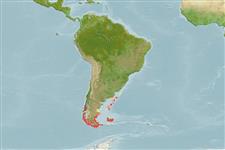Anthozoa |
Actiniaria |
Actiniidae
Environment: milieu / climate zone / depth range / distribution range
Ecology
Sessile. Subtropical
Southwest Atlantic and Southeast Pacific: Argentina, Chile and Falkland Islands.
Length at first maturity / Size / Weight / Age
Maturity: Lm ? range ? - ? cm
This species is found on boulder beaches in rocky crevices and between mytilids, particularly in intertidal areas (Ref. 87801).
Life cycle and mating behavior
Maturity | Reproduction | Spawning | Eggs | Fecundity | Larvae
Members of the class Anthozoa are either gonochoric or hermaphroditic. Mature gametes are shed into the coelenteron and spawned through the mouth. Life cycle: The zygote develops into a planktonic planula larva. Metamorphosis begins with early morphogenesis of tentacles, septa and pharynx before larval settlement on the aboral end.
Häussermann, V. and G. Försterra. 2009. (Ref. 87801)
IUCN Red List Status (Ref. 130435)
CITES status (Ref. 108899)
Not Evaluated
Not Evaluated
Threat to humans
Harmless
Human uses
| FishSource |
Tools
More information
Age/Size
Growth
Length-weight
Length-length
Morphology
Larvae
Abundance
Internet sources
Estimates based on models
Preferred temperature
(Ref.
115969): 6.8 - 7.9, mean 7.3 (based on 112 cells).
